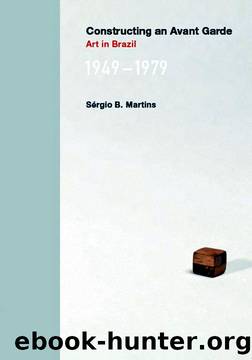Constructing an Avant-Garde: Art in Brazil, 1949-1979 by Sérgio B. Martins

Author:Sérgio B. Martins [Martins, Sérgio B.]
Language: eng
Format: epub
ISBN: 9781461952374
Google: ezymjwEACAAJ
Publisher: MIT Press
Published: 2013-07-15T01:04:24.719025+00:00
3.16 Carlos Zilio, Unknown Identity, 1973. Photograph, 18 x 24 cm. Courtesy of the artist.
3.17 Carlos Zilio, For a Young Man of Brilliant Prospects, 1974. Multiple, photographic series, 18 x 24 cm. Courtesy of the artist.
3.18 Carlos Zilio, Self-Portait Aged 26, 1970. Hydrographic pen on paper, 47.3 x 32.5 cm. Courtesy of the artist.
3.19 Carlos Zilio, Pieces of Mine, 1971. Gouache on paper. 50 x 32.5 cm. Courtesy of the artist.
"With Tiradentes," Cildo Meireles explains, "I was interested in metaphor and in the dislocation of the theme. I wanted to use the subject, life and death, as the raw material of the work. The dislocation is what matters in the history of the art object."' Meireles refers to his 1970 work titled Tiradentes: Totem-Monument to the Political Prisoner, in which live chickens were tied to stake, soaked in gasoline, and burned alive. Performed in the city of Belo Horizonte, this extreme act was a direct response to an event taking place in the nearby historical town of Ouro Preto. The military government had temporarily transferred the capital of the country from Brasilia to Ouro Preto in order to commemorate the death of Tiradentes (Joaquim Jose da Silva Xavier, who was imprisoned, executed, and quartered in 1792 after leading a revolt against the Portuguese colonial rule, is commonly known by this name). Or, rather, the military's intent was to appropriate the event for the sake of its own nationalist self-legitimizing rhetoric, made all the more cynical by the fact that one of the main detention centers for political prisoners at that time was called... Tiradentes Prison. For Meireles, then, the work was first and foremost a way of subverting that commemorative relocation of the capital from Brasilia, itself the product of a major human and material displacement, with a displacement of another kind-one that exceeded pure symbolism and crossed the threshold of trauma. "Of course I would never repeat a work like Tiradentes," Meireles adds, "I can still hear the poor hens in my emotional memory. But in 1970 I felt that it had to be done."2
Critic Paulo Herkenhoff has argued that this work generates "an image of liberty by linking the complex figure of Tiradentes into present-day politics."3 There was indeed a fundamental distance inscribed in Tiradentes, as if its shock was meant to possess a muffled rather than vivid quality-the work took place in a courtyard, and the public witnessed it from inside the exhibition space, separated from it by a glass wall.4 This is perhaps what an "image of liberty" could be expected to retain and circulate. As a matter of fact, Frederico Morais, who curated the "From Body to Earth" exhibition, where Tiradentes was performed, recalls that the work did provoke scandalized reactions in members of the local Chamber of Representatives.5 This is also a sign of Meireles's awareness of conceptualist strategies of circulation, and of the way information can be made to supersede the actual work.
Download
This site does not store any files on its server. We only index and link to content provided by other sites. Please contact the content providers to delete copyright contents if any and email us, we'll remove relevant links or contents immediately.
Aircraft Design of WWII: A Sketchbook by Lockheed Aircraft Corporation(31772)
The Great Music City by Andrea Baker(21313)
Call Me by Your Name by André Aciman(18965)
The Art of Boudoir Photography: How to Create Stunning Photographs of Women by Christa Meola(17841)
Shoot Sexy by Ryan Armbrust(17142)
Plagued by Fire by Paul Hendrickson(16637)
The Secret History by Donna Tartt(16624)
Portrait Mastery in Black & White: Learn the Signature Style of a Legendary Photographer by Tim Kelly(16484)
Adobe Camera Raw For Digital Photographers Only by Rob Sheppard(16387)
Photographically Speaking: A Deeper Look at Creating Stronger Images (Eva Spring's Library) by David duChemin(16161)
Bombshells: Glamour Girls of a Lifetime by Sullivan Steve(13109)
Pimp by Iceberg Slim(12931)
Ready Player One by Cline Ernest(12838)
The Goal (Off-Campus #4) by Elle Kennedy(12433)
Art Nude Photography Explained: How to Photograph and Understand Great Art Nude Images by Simon Walden(12348)
Kathy Andrews Collection by Kathy Andrews(10520)
Thirteen Reasons Why by Jay Asher(7788)
Wonder by R.J. Palacio(7732)
Goodbye, Things by Fumio Sasaki(7728)
